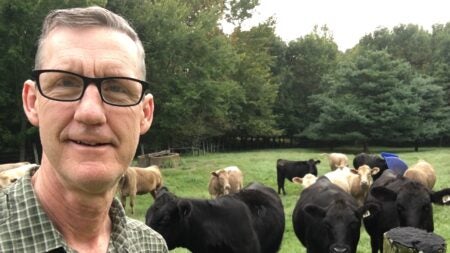
Colin Derdeyn, MD
Colin Derdeyn, MD, joined UVA Department of Radiology and Medical Imaging, effective January 2, 2024. Dr. Derdeyn is a renowned physician scientist and national leader in improving stroke care of patients across the country. He joined UVA from the University of Iowa Hospitals and Clinics, where he served as chair of the Department of Radiology and principal investigator for two ongoing multi-institutional NIH-funded studies examining innovative approaches to stroke care. Dr. Derdeyn is also a double Hoo, earning both his bachelor’s and medical degrees from UVA.
We recently had a chance to talk with Dr. Derdeyn about what drew him back to UVA, why he chose academic medicine, and new imaging technology and image-guided therapy that keep his field on the forefront of patient care.
Q. Why did you choose the UVA School of Medicine Department of Radiology and Medical Imaging?
A. This is one of the best programs in the country and the people and resources here put us in a unique position to accomplish some great things. I was very impressed with the alignment and vision of the UVA Health leadership. This institution is headed in the right direction: a commitment to growth of the clinical and research enterprise, excellence in patient care, and excellence in education. A few things that illustrate how well this is underway here – the growth in NIH research funding, commitment to the Paul and Diane Manning Institute of Biotechnology, and the Press-Ganey survey results for our department – over 97% of our patients are likely to recommend us to others. This puts us in the top 10% nationally. This statistic is a great barometer of what an amazing team we have here – it rolls up all aspects of a patient’s experience from scheduling to getting the results of their study or procedure. There are also so many opportunities for collaboration within the medical school and across the grounds – like biomedical engineering and the new School for Data Science.
Q. Why academic medicine?
A. I chose academic medicine because of the impact and relationships you can develop. Academic medicine is where we make all the big leaps forward in patient care, through research and innovation. It is such a dynamic field. In my career, I have had the privilege of helping to develop revolutionary advances in the care of people with brain aneurysms and stroke. We are able to achieve much better outcomes for many of these patients now. These efforts have involved colleagues across the world. In addition, we have the opportunity to train the next generation of physicians, investigators, and allied health professionals. The relationships we develop with our trainees are lifelong and sustaining.
Q. What inspired you to become a doctor/provider? Why did you choose your specialty?
A. Alot of things drew me to radiology. The intellectual exercise of figuring out what was going on – connecting imaging findings with the clinical question. Every study we open can be a puzzle or mystery to solve. The tremendous impact that all this has on patient care. And finally, the collaboration and partnership with our referring physicians: I like working with a team. I also gravitated to the interventional part of the field – I like procedures too – working with my hands, the powerful human aspects of direct patient care, and the teamwork with our techs, nurses, APPs that is required to do it well.
Q. What’s the most exciting thing happening in your field right now?
A. We are always bringing new imaging technology and image-guided therapy to patient care. On the imaging technology side, I am really excited about new CT technology – photon-counting CT that promises real advances in anatomic detail and the ability to measure physiological processes better. Machine Learning/Artificial Intelligence is another new technology that will have major impact on our field – from image data analysis as a diagnostic aid or screening tool, automated processing routines for quantification and measurement, building predictive models that use EMR, imaging, and genetic data to guide personalized care, and developing generative AI and natural language processing for reporting or communication.
Q. How do you spend your time away from work? Hobbies?
A. I love being in the mountains, woods or fields – working or just walking. We have a family farm in Nelson County and I serve as an unpaid assistant farm manager for my mother. There is a lot to do there. I also really enjoy biking. I picked that up in Iowa and am excited to do that here.
Filed Under: Faculty
